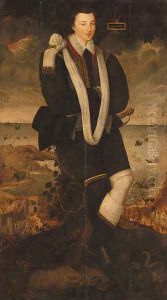Marcus The Younger Gheeraedts Paintings
Marcus Gheeraerts the Younger was a prominent figure in the world of art during the late 16th and early 17th centuries. Born in Bruges in 1561, he was part of a dynasty of artists; his father, Marcus Gheeraerts the Elder, was also a painter and printmaker. The Gheeraerts family moved to England in the late 1560s to escape religious persecution in the Spanish Netherlands. This relocation played a crucial role in shaping Marcus the Younger's career, embedding him in the cultural and artistic landscape of Elizabethan and Jacobean England.
Gheeraerts the Younger is best known for his work as a portraitist, capturing the likenesses of some of the most significant figures of his time, including Queen Elizabeth I, in what is considered one of his masterpieces, the 'Ditchley Portrait'. His style was noted for its emphasis on realism and detail, as well as its subtle use of symbolism, which was a departure from the more rigid and formal portraiture of earlier periods. This approach made him a favorite among the English nobility and court, for whom he created numerous portraits, illustrating not just their physical appearance but also their power, wealth, and taste.
His contributions to art were not limited to portraiture. Gheeraerts was also involved in printmaking and pageantry, designing costumes and scenery for court masques and other entertainments, which were an important part of cultural life at the court of Elizabeth I and James I. These works, though less well-preserved than his portraits, further demonstrate his versatility and creativity as an artist.
Despite his success, little is known about Gheeraerts's personal life, and his work was somewhat overshadowed in the centuries following his death in 1636. However, in recent years, there has been a resurgence of interest in his oeuvre, leading to a reevaluation of his place within the canon of English art. Today, Marcus Gheeraerts the Younger is recognized not only for his contribution to the development of English portraiture but also for his role in the cultural interchange between the Low Countries and England during a pivotal moment in European history.
